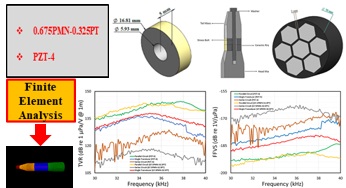Design, development and characterization of a mid-frequency (35 khz) tonpilz transducer array from 0.675PMN-0.325PT piezoceramics
DOI:
https://doi.org/10.55713/jmmm.v32i1.1249คำสำคัญ:
Tonpilz transducer, Piezoelectricity, PMN-PT, FEAบทคัดย่อ
A mid-frequency tonpilz transducer array was designed and analyzed by finite element method using commercial ATILA code and constructed using piezoceramic rings with lead magnesium niobate (PMN)-lead titanate (PT) composition. The morphotropic phase boundary (MPB) 0.675Pb(Mg1/3Nb2/3)O3-0.325PbTiO3 composition was chosen to obtain higher performance from the transducer due to the superior dielectric and electromechanical properties of the MPB compositions. A pure perovskite phase was obtained from the ceramics. Piezoelectric charge coefficient (d33) was measured as 435 pC×N-1. Single tonpilz element and an array consisting of 7-unit array were constructed and later potted in polyurethane for underwater measurements. A second array was also constructed for comparison from commercial hard Pb(Zr,Ti)O3-PZT ceramics. The longitudinal piston mode vibration frequency of the tonpilz transducer was measured around 33 kHz in air and around 35 kHz in water. The PMN-PT based array was found to have a comparable transmit performance and a superior receive performance compared to PZT.
Downloads
เอกสารอ้างอิง
C. B. Carter, and M. G. Norton, Ceramic Materials: Science and Engineering, 2a, New York: Springer-Verlag, 2013.
N. Setter, and R. Waser, “Electroceramic materials,” Acta Materialia, vol. 48, pp. 151-178, 2000.
K. Uchino, “Manufacturing methods for piezoelectric ceramic materials,” Advanced Piezoelectric Materials, Elsevier, pp. 385-421, 2017.
S. C. Thompson, R. J. Meyer, and D. C. Markley, “Performance of tonpilz transducers with segmented piezoelectric stacks using materials with high electromechanical coupling coefficient,” Journal of the Acoustical Society of America, vol. 135, no. 1, pp. 155-164, 2014.
P. Kurt, M. Şansal, İ. Tatar, C. Duran, and S. Orhan, “Vibro-acoustic design, manufacturing, and characterization of a tonpilz- type transducer,” Applied Acoustics, vol. 150, pp. 27-35, 2019.
C. H. Sherman, and J. L. Butler, Transducer and arrays for underwater sound, New York: Springer; 2007.
A. D’Amico, and R. Pittenger, “A brief history of active sonar,” Aquatic Mammals, vol. 35, no. 4, pp. 426-434, 2009.
K. H. Brosnan, G. L. Messing, D. C. Markley, and R. J. Meyer, “Comparison of the properties of tonpilz transducers fabricated with ⟨001⟩ fiber-textured lead magnesium niobate-lead titanate ceramic and single crystals,” The Journal of the Acoustical Society of America, vol. 126, no. 5, pp. 2257-2265, 2009.
H. Kim, and Y. Roh, “Design and fabrication of a wideband tonpilz transducer with a void head mass,” Sensors and Actuators A: Physical, vol. 239, pp. 137-143, 2016.
R. J. Meyer, T. C. Montgomery, and W. J. Hughes, “Tonpilz transducers designed using single crystal piezoelectrics,” presented at the Oceans 2002 IEEE/MTS, Biloxi, MS, pp. 29-31, 2002.
R. Rouffaud, C. Granger, A-C. Hladky-Hennion, M. P. Thi, and F. Levassort, “Tonpilz underwater acoustic transducer integrating lead-free piezoelectric material,” Physics Procedia, vol. 70, pp. 997-1001, 2015.
S-E. Park, and T. R. Shrout, “Characteristics of relaxor-based piezoelectric single crystals for ultrasonic transducers”, IEEE Transactions on Ultrasonics, Ferroelectrics, and Frequency Control, vol. 44, no. 5, pp. 1140-1147, 1997.
S. Pyo, M. S. Afzal, Y. Lim, S. Lee, and Y. Roh, “Design of a wideband tonpilz transducer comprising non-uniform piezo-ceramic stacks with equivalent circuits,” Sensors, vol. 21, p. 2680, 2021.
S. Swartz, and T. Shrout, “Fabrication of perovskite lead magnesium niobate,” Materials Research Bulletin, vol. 17, no. 10, pp. 1245-1250, 1982.
L. B. Kong, J. Ma, and W. Zhu, “Preparation of PMN powders and ceramics via a high-energy ball milling process,” Journal of Materials Science Letters vol. 20, pp. 1241-1243, 2001.
A. Berksoy-Yavuz, and E. Mensur-Alkoy, “Enhanced soft character of crystallographically textured mn-doped binary 0.675[Pb(Mg1/3Nb2/3)O3]-0.325[PbTiO3] Ceramics,” Journal of Electronic Materials, vol. 47, no. 11, pp. 6557-6566, 2018.
A. Berksoy-Yavuz, and E. Mensur-Alkoy, “Electrical properties and impedance spectroscopy of crystallographically textured 0.675[Pb(Mg1/3Nb2/3)O3]-0.325 [PbTiO3] ceramics,” Journal of Materials Science: Materials in Electronics, vol. 29, no. 15, pp. 13310-13320, 2018.
M. Y. Kaya, E. Mensur-Alkoy, A. Gurbuz, M. Oner, and S. Alkoy, “Influence of compositional variation on the electrical properties of [Pb(Zn1/3Nb2/3)O3]-[Pb(Zr,Ti)O3] ceramics and their transducer application,” IEEE Transactions on Ultrasonics, Ferroelectrics and Frequency Control, vol. 65, no. 7, pp. 1268-1277, 2018.
A. C. Hladky-Hennion, S. Alkoy, D. Markley, R. E. Newnham, R. Meyer, and W. J. Hughes, “Analysis of transducers arrays from piezoelectric hollow spheres,” Proceedings of the 2002 IEEE Ultrasonics Symposium, vol. 2, pp. 1239-1242, 2002.

ดาวน์โหลด
เผยแพร่แล้ว
วิธีการอ้างอิง
ฉบับ
บท
การอนุญาต
ลิขสิทธิ์ (c) 2022 Journal of Metals, Materials and Minerals

This work is licensed under a Creative Commons Attribution-NonCommercial-NoDerivatives 4.0 International License.
Authors who publish in this journal agree to the following terms:
- Authors retain copyright and grant the journal right of first publication with the work simultaneously licensed under a Creative Commons Attribution License that allows others to share the work with an acknowledgment of the work's authorship and initial publication in this journal.
- Authors are able to enter into separate, additional contractual arrangements for the non-exclusive distribution of the journal's published version of the work (e.g., post it to an institutional repository or publish it in a book), with an acknowledgment of its initial publication in this journal.












